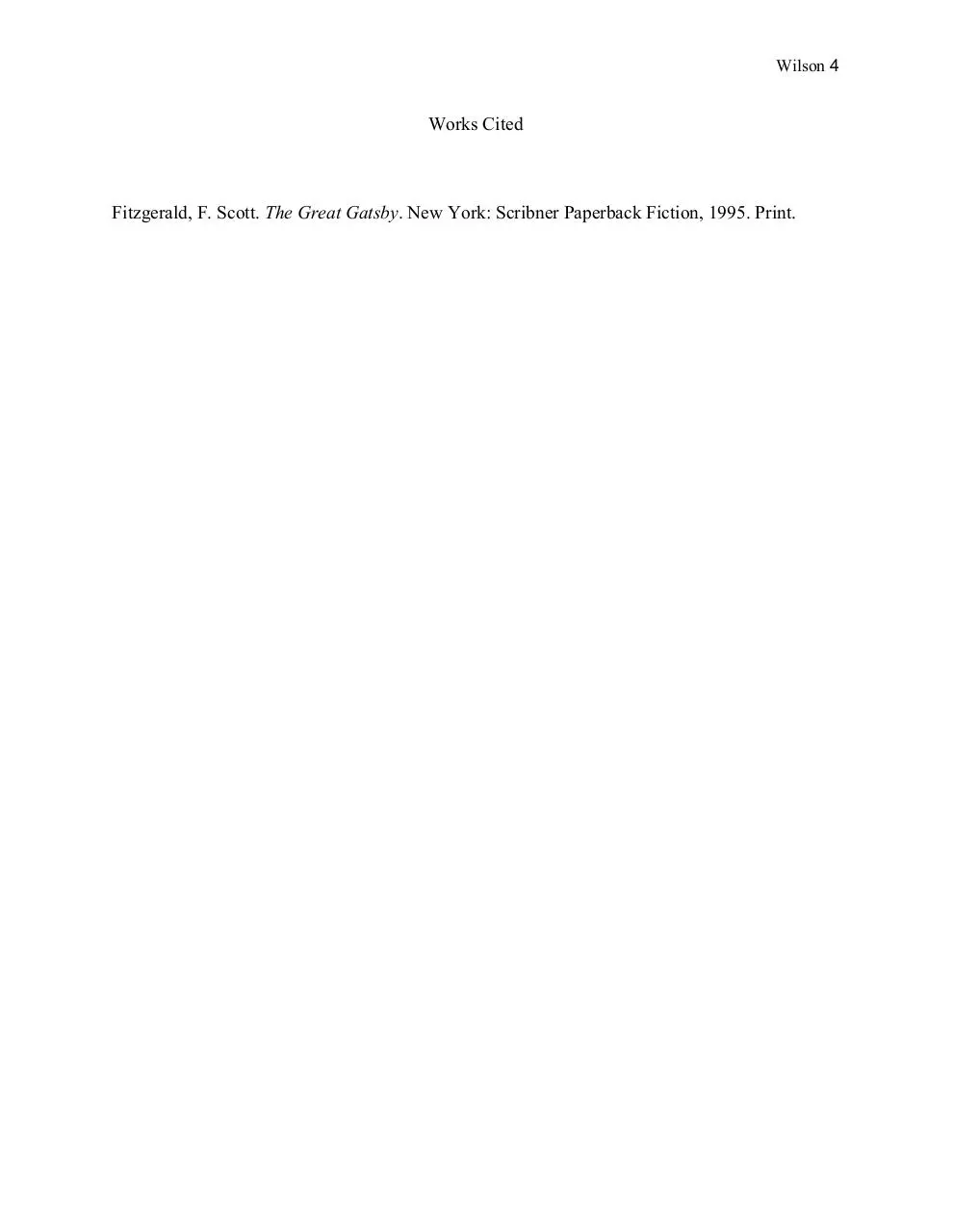Great Gatsby Essay Sydney Wilson (PDF)
File information
This PDF 1.5 document has been generated by / Skia/PDF m67, and has been sent on pdf-archive.com on 06/04/2018 at 21:12, from IP address 96.4.x.x.
The current document download page has been viewed 535 times.
File size: 86.7 KB (4 pages).
Privacy: public file




File preview
Wilson 1
Sydney Wilson
Mrs. Brianne Matheney
Honors English II
8 December, 2016
The American Dream
Morals are like an unwritten code of behavior. People expect other people to act a certain
way and know not to do or say certain things. Morals are the star of corruption in F.Scott
Fitzgerald’s The Great Gatsby. Nick Carraway moves to New York and settles in a place called
West Egg. He meets a wealthy man named Gatsby who throws lavish parties for many people.
He soon finds out Gatsby is helplessly in love with Nick’s rich, married cousin, Daisy. Gatsby
tries with all his might for five whole years to earn back Daisy’s love, but when Daisy chooses
her husband Tom, Gatsby’s dream is dead. Fitzgerald supports the theme of the withering of the
American dream through the presentation of the Valley of Ashes, the dust that eats at Gatsby’s
dreams, and the moral decay of the upper class.
The Valley of Ashes is the place where factories dump ashes and other waste they do not
need which the author describes : “This is a valley of ashes—a fantastic farm where ashes grow
like wheat into ridges and hills and grotesque gardens” (Fitzgerald 23). The Valley of Ashes
shows the moral decay that the city and the upper class hide and Fitzgerald presents this with this
oxymoron inside the quote: “grotesque gardens” (23). The people who live here lose their vitality
and the life they have inside of them: “The ash-grey men swarm up with leaden spades and stir
up an impenetrable cloud, which screens their obscure operations from your sight” (23).The
people who live here lose their sense of excitement, and anyone can see that as this quote talks
Wilson 2
about people as if they are animals. This setting shows how the pursuit of wealth leads to moral
decay and traps these poor people in this environment.
The same dust that settles in the Valley of Ashes eats at Gatsby’s dream: "it is what
preyed on Gatsby, what foul dust floated in the wake of his dreams that temporarily closed out
my interest in the abortive sorrows and short-winded elations of men" (2). Gatsby is wrapped up
in getting more money but ends up ruining his own morals in the process. Gatsby tries to impress
Daisy with his wealth and possessions, and she comes to understand this: “ ‘They’re such
beautiful shirts,’ [Daisy] sobbed, her voice muffled in the thick folds. ‘It makes me sad because
I’ve never seen such beautiful shirts-such beautiful shirts’ ” (92). She sees that he has changed
himself for her, but they have both changed so much that the past is just too far away. The
morals he gained from his upbringing in the West have been compromised because of his focus
on his dream: money.
The upper class think of themselves as untouchable, so they have no compassion for
others and show no sense of the morals they should possess. They show this several times
throughout the novel: “There was an unmistakable air of natural intimacy about the picture, and
anybody would have said that [Tom and Daisy] were conspiring together” (145). This happens
after Daisy kills Myrtle on the way home from New York, and their first thought is to cover their
own tracks when a woman is dead and her husband is devastated. Daisy and Tom are used to
having people clean up their messes: “I called up Daisy half an hour after we found [Gatsby],
called her instinctively and without hesitation. But she and Tom had gone away early that
afternoon, and taken baggage with them” (164). They took off and hoped the mess would go
Wilson 3
away on its own. They do not care who has to go down for them which shows the lack of caring
and compassion the upper class possesses.
In The Great Gatsby, there is a constant theme: the withering of the American dream that
is shown through several ways throughout the book. It is shown through the Valley of Ashes
where people are trapped by their pursuit of money. It’s also characterized by the parasitic dust
that eats at Gatsby’s dream which is money once again causing people to stray from a good path.
The last way it is presented is through the carelessness of the upper class which is the ultimate
display of moral decay caused by money. Fitzgerald shows his audience how money can affect
people in negative ways and cause them to forget the simple life lessons and morals they have
learned.
Wilson 4
Works Cited
Fitzgerald, F. Scott. The Great Gatsby. New York: Scribner Paperback Fiction, 1995. Print.
Download Great Gatsby Essay-Sydney Wilson
_Great Gatsby Essay-Sydney Wilson.pdf (PDF, 86.7 KB)
Download PDF
Share this file on social networks
Link to this page
Permanent link
Use the permanent link to the download page to share your document on Facebook, Twitter, LinkedIn, or directly with a contact by e-Mail, Messenger, Whatsapp, Line..
Short link
Use the short link to share your document on Twitter or by text message (SMS)
HTML Code
Copy the following HTML code to share your document on a Website or Blog
QR Code to this page

This file has been shared publicly by a user of PDF Archive.
Document ID: 0000754065.